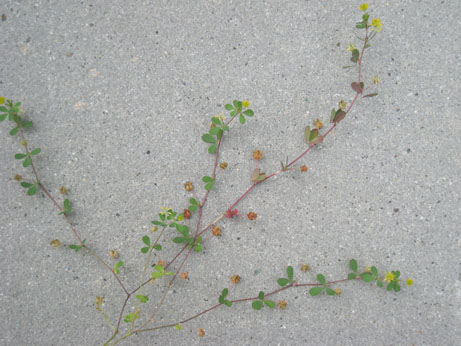
|
| Little Hop-Clover; Trifolium dubium Sibth. |
Pea Family; LEGUMINOSÆ (FABACEÆ)
|
| Seattle has no native Trifolium species remaining, but at least nine European invaders now grow wild here. Of these nine, the
least weedy and most lovely is Crimson Clover (T. incarnatum), a real heart-throbbing red that would do is a favor if it
would grow commonly. |
| Clovers, like most members of the pea family, are valuable for farming and agriculture. Fixing nitrogen symbiotically,
they enrich even sterile soils. Their honey-laden flowers make bees delirious with joy. Their high-protein foliage is superb livestock
food. Many species of clover exist, one or another suited to practically any site. Some of them are so adaptable, so successful, that
they know no bounds and have covered the planet as only weeds can do. It is just such a one that is our pet this month. |
| Of all nine Seattle clovers, none is smaller or more despised. Its names are illustrative of the low esteem it is held, and of
its low stature: Small Hop-Clover, Lesser Trefoil, Least Hop-Clover. It's also been called Suckling Clover and, like many similar
plants, Shamrock. |
| Little Hop-Clover also has its Latin name, of course.
Dubium means doubtful. Without any doubt this weed is wholly devoid of glamor or utility, other than its nitrogen-fixing role and bee value. From human viewpoints, it is an unsightly pest, damnably hard
to combat since it is both tiny and usually abundant, reseeding madly. |
| It germinates in early spring, say January and February, and dies in the heat of the summer, or persists into September
if watered. Growing more or less prostrate, it stealthily sends slender stems among grasses in our lawns. After bearing numerous
little yellow flowers in spring (chiefly April through June), the stems turn reddish and the spent blossoms pale, dull brown. Poor,
patchy lawns and sunny sandy soil are its preferred nesting quarters. When you see a lawn with a bunch of little yellow clover, this is it.
Of course, make sure you do not mistake a yellow-flowered
Oxalis or sorrel for a clover. Look closely at the illustration. The
Oxalis often is purplish, and has a sour taste. |
You can eat the tender tips of Hop-Clover, but it has not the substance of bigger clovers (which is to say all others), so
why bother? To eliminate it, assiduously prevent your population from ripening seeds. No easy task, because this weed can lurk
among low-mowed grass just fine. Pluck them on site. Next month we'll feature a larger, more useful, less common yellow-flowered
relative of this rascal.
|
w
Originally published as the Seattle Tilth newsletter Weed of the Month in March 1995, along with an illustration from a book.
Back |
|
|

